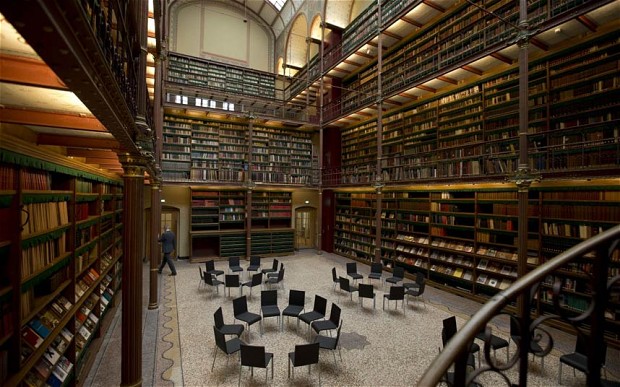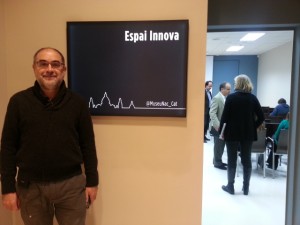Alfons Cornella
In the context of rethinking the museum and extending the internal reflection and debate, we invited Alfons Cornella, an expert in innovation, to give a talk to the staff and to be guest author of the blog. Below you will also find the complete video of his stimulating talk.
Innovating is not a whim. Innovating is not a new action in the organisations. We’ve always innovated, but in more impulsive and maybe invisible ways. The challenge now is to innovate systematically and in teams. We have to incorporate the creation of permanent value as one of the values of the organisation, and as a natural activity (“on a day-to-day basis”). We have to understand the new needs better, as well as the new impulses, the emerging concerns of our “clients” (or, in a wider sense, of the citizens and visitors), and to respond with proposals that add new value. Innovating means understanding the problems and the opportunities that surround us, so as to generate new ideas in a creative way, which can be turned into a value for the different agents around us, by creating results (social, economic, etc.) and which are sustainable in time. To create value in accordance with our values.
Innovating requires the combination of attitude and method. Of vision and system. To innovate requires the willingness to take risks and the method to experiment.
To Explore
It is necessary to EXPLORE the world (what the others are doing, well or badly; what the people want, what is disruptive, what is absurd, what seems absurd but ends up being intelligent, which models of business are changing, how, who is doing it, where, why, etc.). To look where you haven’t looked before, and to extract ideas in a systematic way that can be worked on in a team as a source of opportunities. It is necessary to become experts in the “mining of opportunities”. Today, in the current state of complexity of the world, with the enormous spectre of proposals in some place on the planet, it is absurd to sit down and think up some innovation without beforehand having dedicated some time to look around you. Exploring is a fundamental requirement for innovating in a productive way.
Value and Emotion
Afterwards, it is necessary to learn to understand what the VALUE is for our clients (or users, or citizens _use here the most convenient terminology). And, in a growing way, it is necessary to understand that in the rational/irrational tandem, or efficiency/emotion, in our brain, it is the irrationality, the emotionality, that takes control of many aspects of our behaviour. The beauty, the elegance, the subtlety of the instants, the power of the stories captivate us. In recent decades we have learnt that our brain is basically emotional. And this has a growing relevance for cultural institutions. Because culture is a vehicle of profound connection with the EMOTIONS: the imaginative reading, the inspiration of the images, the vehicle of the history, the sympathy with moments and places that we can only imagine because they no longer exist. Culture, and art, have in this context the domain of the “brain-emotion” a potential to explore: the potential of “the stories of the History”. No wonder that some of the most attractive initiatives in culture, and especially in museums, in recent years are related to storytelling. The project “A history of the world in 100 objects”, of the British Museum, or the different initiatives for presenting moments and places from past history in the form of augmented reality (the digitization of the Forum of Augustus, or the Roman Baths, or of Pompey, or of the Roman Barcino), they are examples of the conversion of the emotional potential of our “heritage” (understood in the widest sense: the past that we can relive) in products, services, activities, actions that have a growing value for the different agents of the society.
New Formats: Storytelling
The new TECHNOLOGIES help, obviously, to make it possible to extract new value from the existing heritage. They enable their “presentation” in different, innovative and attractive FORMATS. They allow the “formatting” of content in stories, of emotions articulated in different ways. Thus, for example, you could think of organising the “catalogue” of a museum based on simple “driver words”. Can you imagine an “understanding” of the museum based on the word “Realities”? (what the reality was like, the day-to-day, of the middle ages, of the romantics, of the turn-of-the-century, of the pre-war, etc.). Or of the word “Dreams”? (imaginary dreams that free the artists of the mean artists of the time that they were to live). And around the word “Nothing” Or “All”?
Co-Innovation
All this new scenario of appreciation of our heritage requires a bold attitude, a system of innovation (methods and tools), which begins with a “mining” of our ASSETS: what are we the best at (in the world), what makes us different, how are we attractive? Once these assets have been mapped, we have to start working on “agile” PROJECTS (short, iterative with a direct relation with the market; with the methodology that is nowadays called Lean startup) that show the agents of the system (especially the “clients” and the “payers”), that the new proposals have value, and are sustainable in time. And, moreover, it is necessary to determine “who” you make a partnership with to carry out the projects, with a scheme of CO-INNOVATION, of collaborative innovation, that demonstrates that today the most intelligent way of competing is to collaborate.
Innovating is not a whim. It’s being alive.
(Podcast in Catalan)
Related links
Cultural Innovation International Prize, CCCB
Alfons Cornella. Founder Infonomia.com and co-society.com









